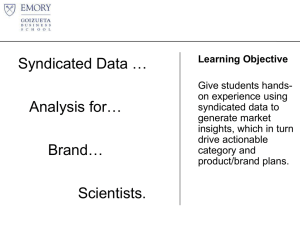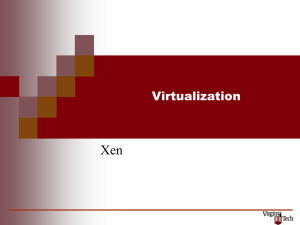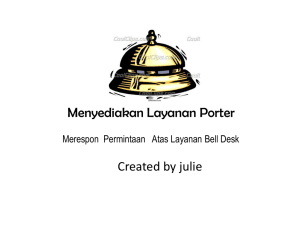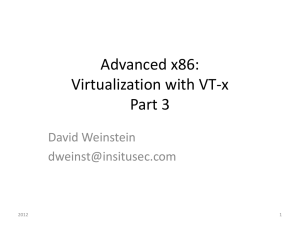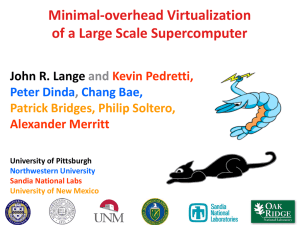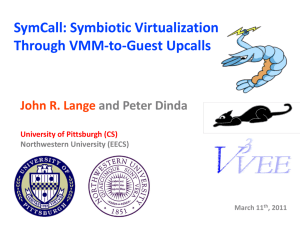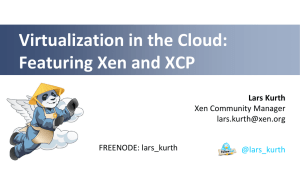lec04-Xen
advertisement
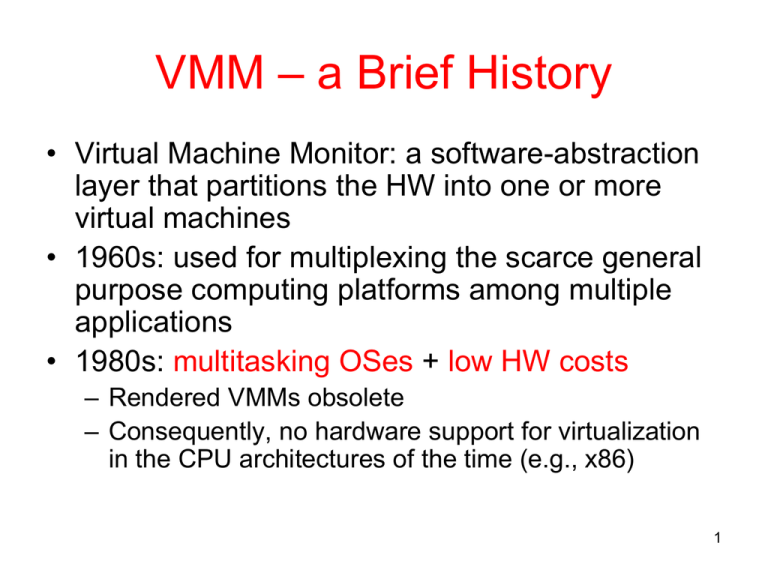
VMM – a Brief History • Virtual Machine Monitor: a software-abstraction layer that partitions the HW into one or more virtual machines • 1960s: used for multiplexing the scarce general purpose computing platforms among multiple applications • 1980s: multitasking OSes + low HW costs – Rendered VMMs obsolete – Consequently, no hardware support for virtualization in the CPU architectures of the time (e.g., x86) 1 And now… Compared to “cloud computing” (in red) 2 Why this revival? • Virtual Machine Monitor: a software-abstraction layer that partition the HW into one or more virtual machines • 1960s: used for multiplexing the scarce general purpose computing platforms among multiple applications • 1980s: multitasking OSes + low cost hardware – Rendered VMMs obsolete • 2000s: multitasking OSes + low cost hardware – Revived VMMs 3 Cause and Solution • Increased OS functionality: – More capable OSes: • Fragile and vulnerable • Low cost hardware: – Proliferation of machines: • Underused • With high space and management overhead • Solution: back to one application per machine – Per virtual machine – This time: VMM as a means of multiplexing hardware for server consolidation • Solution for security and reliability 4 VMM: Decoupling the HW and the OS by a layer of indirection • Uniform view of underlying HW, – so virtual machines can run on any hardware • Complete encapsulation of a virtual machine’s software state, – so migration is much easier • Total mediation of all interactions between the virtual machine and the underlying HW, – thus allowing strong isolation between VMs 5 Big Picture (and Terminology) Virtual Machine Guest OS 6 Xen (Original slides by Kishore Ramachandran adapted by Anda Iamnitchi) 7 Key points • Goal: extensibility and flexibility akin with Exokernel/Micro-kernel goals • Main difference: granularity of operating systems rather than applications – running several commodity operating systems on the same hardware simultaneously without sacrificing performance or functionality • Why? – – – – – Application mobility Server consolidation Co-located hosting facilities Distributed web services Secure computing platforms 8 Possible Virtualization Approaches • Standard OS (such as Linux, Windows) – Meta services (such as grid) for users to install files and run processes – Administration, accountability, and performance isolation become hard • Retrofit performance isolation into OSs – Accounting resource usage correctly can be an issue unless done at the lowest level and very fine granularity (e.g., Exokernel) • Xen approach – Multiplex physical resource at OS granularity 9 Full Virtualization • Make hw completely invisible to the OS • Virtual hardware identical to real one – Relies on hosted OS trapping to the VMM for privileged instructions – Pros: run unmodified OS binary on top – Cons: • supervisor instructions can fail silently in some hardware platforms (e.g. x86) – Solution in VMware: Dynamically rewrite portions of the hosted OS to insert traps • need for hosted OS to see real resources: real time, page coloring tricks for optimizing performance, etc… 10 Paravirtualization • Presents a virtual machine abstraction similar but not identical to the underlying hardware – Pros: • allows strong resource isolation on uncooperative hardware (x86) • enables optimizing guest OS performance and correctness – Cons: • Need to modify the guest OS 11 (More) Background • ABI, signals, interrupts, system calls – ABI defines the machine as seen by process • The non-virtualizable x86 architecture – Visibility of privileged state: the guest can observe it has been deprivileged when reads its code segment selector – Lack of traps when privileged instructions run at unprivileged level: instructions fail silently 12 Xen Principles • Support for unmodified application binaries • Support for multi-application OS – Complex server configuration within a single OS instance • Use paravirtualization in order to support uncooperative architectures such as x86 • Enable guest OSes to optimize performance and correctness 13 14 Challenges • CPU virtualization –… • Memory virtualization –… • I/O virtualization –… 15 Xen: Memory Management • What would make memory virtualization easy – Software TLB – Tagged TLB =>no TLB flush on context switch • Tag identifies a different address space X86 does not have either • Xen approach – Guest OS responsible for allocating and managing hardware page tables – Every guest OS has its own address space – Xen occupies top 64MB of every address space. Why? • To save moving between address spaces (hypervisor calls), no TLB flush • Xen code and its data structures • Cost? 16 Physical Memory • At domain creation, hardware pages “reserved” • Domain can increase/decrease its quota • Xen does not guarantee that the hardware pages are contiguous • Guest OS can maintain its own mapping of “contiguous” “physical memory” mapped to the “hardware pages” 18 • Creating a new Page Table by Guest OS – (every process has its own page table) – allocate and initialize a page and registers it with Xen to serve as the new page table – all subsequent updates to this page via Xen – can batch updates to reduce the cost of entering and exiting Xen • Segmentation by guest OS virtualized similarly 19 Virtual Address Translation • Xen solution – Physical memory is not contiguous for guest OS • Fundamental shift from the traditional view of the HW – Register guest OS PT directly with MMU – Guest OS has read only access to the PT • All modifications to the PT via Xen • Why? – Type associated with a page frame • PD, PT, LDT, GDT, RW (terminology specific to x86 architecture) • All except RW: read-only access to the page for guest OS • Guest OS can retask a page only when ref count is 0 20 Xen: CPU Virtualization • Four privilege levels in x86 – – – – • Ring 0: originally for OS (now Xen) Ring 1: originally not used (now guest OS) Ring 3: originally for applications (now applications of the guest OS) Ring 2: originally not used (now for shared libraries for supporting user processes in Ring 3) Privileged instructions – Validated and executed in Xen (e.g., installing a new PT) • Exceptions – Registered with Xen once. Accepted (validated) if don’t require to execute exception handlers in ring 0. – Called directly without Xen intervention – All syscalls from apps to guest OS handled this way (and executed in ring 1) • Page fault handlers are special – Faulting address can be read only in ring 0 – Xen reads the faulting address and passes it via stack to the OS handler in ring 1 21 CPU Scheduling • Bounded Virtual Time (BVT) scheduling algorithm [Duda & Cheriton, SOSP 99] – BVT guarantees fairness over a window of time – Keeps track of CPU time allocated to each guest OS. • The guest OS uses its own scheduling techniques for its processes. 22 Time and Timers • Guest OSs have access to – Real time (cycle counter accuracy for real time tasks in guest OSs) – Virtual time (enables time slicing within the guest OS) – Wall clock time (real time + domain changeable offset) • Time zones, particular settings (e.g., 5 minutes fast) • Guest OS maintain their own internal timer queues and use a pair of Xen timers (real and virtual) 23 Xen: Device I/O Virtualization • Set of clean and simple device abstractions • Allows buffers to be passed directly to/from guest OS to I/O devices via shared memory with Xen • I/O rings implement event delivery mechanism for sending asynchronous notifications to the guest OS 24 25 Details of subsystem virtualization • Control transfer – Between the guest OS and Xen – E.g., page table updates and creation • Data transfer – Passing data between Xen and the OS – E.g., the fault address These are used in the virtualization of all the subsystems 26 Control Transfer • Hypercalls from guest OS to Xen – E.g., (set of) page table updates • Events for notification from Xen to guest OS – E.g., data arrival on network; virtual disk transfer complete • Events may be deferred by a guest OS (similar to disabling interrupts) • Hypercalls can be aggregated to save on control transfers between guest OS and Xen 27 Data transfer – I/O rings • Resource management and accountability – CPU time • Demultiplex data to the domains quickly upon interrupt • Account computation time for managing buffers to the appropriate domain – Memory buffers • Relevant domains provide memory for I/O to Xen – Protection guaranteed between different guest OSs • Xen pins page frames during I/O transfer – Used to defer interruptions on data transfers • One I/O ring for each device for each guest OS: e.g., one for writing data to the disk; one for sending network packets; one for receiving network packets; etc. 28 I/O descriptors indirectly reference the actual memory buffers 29 • Each request: unique ID from guest OS • Response: use this unique ID • Network packets – Represented by a set of requests – Responses to these signal packet reception • Disk requests – May be reordered for performance (e.g., elevator) • No copying between Xen and the guest OS (therefore, no performance penalties) • Domain may queue up multiple entries before invoking a hypercall request • Ditto for responses from Xen • I/O rings in memory shared by Xen and guest OS 30 Network • Each guest OS has two I/O rings for network – One for receive and one for transmit – Each ring is a contiguous region of memory • Transmit – Queue descriptor on the transmit ring • Points to the buffer in guest OS space • Page pinned till transmission complete – Round robin packet scheduler across domains • Receive – Network packets written in the receive ring of the destination guest OS – Xen makes an upcall to the guest OS • No copying! 31 Disk • Batches of requests from competing domain taken and scheduled • Since Xen has knowledge of disk layout, requests may be reordered • No copying into Xen • “Reoder barrier” to prevent reordering (may be necessary for higher level semantics such as write ahead log) – It will overwrite the order of the circular I/O memory buffer 32 33 Performance 34

